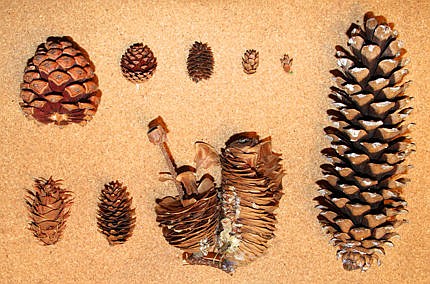Do you know your cones?
Laura Roady Outdoors Columnist | Hagadone News Network | UPDATED 11 years, 1 month AGO
Plink, plink, plink, plop. Plink, plink, plink, plop. The sound of a busy squirrel harvesting cones as they drop to the forest floor. The squirrel is harvesting cones with the seeds still intact so he can stash them for winter.
A few “green” cones may be forgotten by the squirrel and they join the hundreds of other cones in varying stages of decay that have fallen onto the forest floor.
After hearing the squirrel’s chatter, I decided to wander through the woods and see how many different cones I could find. I didn’t find cones from all the conifers in the area but I found nine — from the large western white pine cone to the tiny western redcedar cone.
By far the western white pine has the largest cones in North Idaho at six to 10 inches long. If you’ve ever picked one up, you’ve probably noticed how much pitch is on the cones and subsequently on your hands.
If you’ve picked up a ponderosa pine cone, you’ve probably dropped it quickly because of the prickle on the back of each cone scale. The egg-shaped ponderosa pine cone is often the cone depicted on woodsy-themed items.
The smaller lodgepole pine cone (1.5 to 2 inches long) is also covered with prickles but you’ll be less likely to find it on the forest floor. The often lop-sided cones can hang on a tree for decades, often unopened. Some of the cones are sealed shut by resin that must be melted (usually by a forest fire) to release the seeds.
Grand fir cones are also sparse on the forest floor unless a squirrel has been busy harvesting them. The 2.5- to 4.25-inch barrel-shaped cones of grand fir sit upright on the highest branches until they mature and then the cones disintegrate scale by scale until a central spike is left.
Subalpine fir and whitebark pine cones are the same way, disintegrating on the tree when mature.
The cones of Engelmann spruce open in autumn but wait to drop off until later in winter. The one to two-and-a-half inch cones are oblong to cylindrical with ragged scale edges.
The prominent three-pronged bracts that extend well beyond the scales of the Douglas-fir separate it from other conifer cones. The narrow, two- to 4.5-inch cones fall intact after the seeds have been dispersed.
The cones of western larch also have bracts but they are long and slender. The oval to egg-shaped cones are also smaller than Douglas-fir cones at one to one-and-a-half inches long.
Even smaller are the tan and papery western hemlock cones that litter the forest floor after prolific seed crops. The less than one-inch long cones have wavy scale edges and are light brown at maturity.
The smallest cones belong to the western red cedar. The small, half-inch cones only have a few scales and are more likely to be found on the end of branches than on the forest floor. The seeds of the western red cedar are so small that rodents typically don’t bother to eat them.
Squirrels tend to harvest the cones of Douglas-fir, Engelmann spruce and western white pine but depending on cone crops, they will harvest whatever cones are available to sustain them through winter.
For previous columns and more photos, visit http://goexploreit.blogspot.com
ARTICLES BY LAURA ROADY OUTDOORS COLUMNIST

Spectacular views from the Shorty Peak Lookout
Waking up on top of a mountain as the horizon turns orange with nothing blocking the view is an amazing sight--especially from the comfort of a bed within four walls.

Not all bird eggs are created equal


